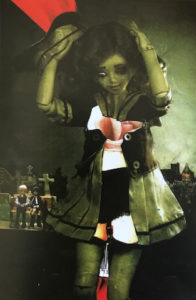A recent show opening this past week (well attended by students, artists and appreciators) was a kaleidoscope of ideas and emotion. The Fl3tch3r Exhibit’s aim is to further social and politically engaged art. The juror, Canadian Anita Kunz, is an internationally published illustrator who selected from over 350 entries coming in from around the world. Because of space restrictions, she eventually had to limit down to a 20% submission ratio. The show is strong. The ideas varied and electrically charged. And, I admit that with some tenderness, even as my own piece was among those passed over. Rejection stings. But good work, well curated, lifts even those who are observing from the reject pool.
Openings are not a good time to really let the whole sink in deeply, so I went back today to consider more. There were the usual political diatribes against prominent public personalities. There were powerful aesthetic statements against guns and drugs and racial violence. Some of that work was remarkably masterful.  But then, I noticed a diminutive collage, chosen as a favorite by the museum staff, “Art to Stop Traffic: What Mercy Requires of Us”. The piece is only 5”x 3.5”. This submission is a poignant contrast, rendered from found images, paper, pen and pencil. The value and color contrast is immediately obvious, but peering closer one sees the uncomfortable juxtaposition of plastic expressions, skin color, garish lighting, things hidden and things exposed.
But then, I noticed a diminutive collage, chosen as a favorite by the museum staff, “Art to Stop Traffic: What Mercy Requires of Us”. The piece is only 5”x 3.5”. This submission is a poignant contrast, rendered from found images, paper, pen and pencil. The value and color contrast is immediately obvious, but peering closer one sees the uncomfortable juxtaposition of plastic expressions, skin color, garish lighting, things hidden and things exposed.
This very idea of things hidden and finally exposed is something I’ve been placing my heart on recently, and so I was gripped again.
Jesus is the one who called this out as a promise to His followers: “for there is nothing covered that will not be revealed”. Such a paradox this: that the ultimate mercy giver is also going to be the final adjudicator. The harshest words He had to say when walking our ground were to the religiously complacent (visualized in this collage). And the most lavish praise he gave was to a woman, not unlike the one pictured in this fragile piece, who wept at His feet. I am moved by this. And I am heartened that the museum staff would even notice a less prominent submission for this very grandest of ideas.
collage by Lucy Julia Hale, Cave Spring, GA